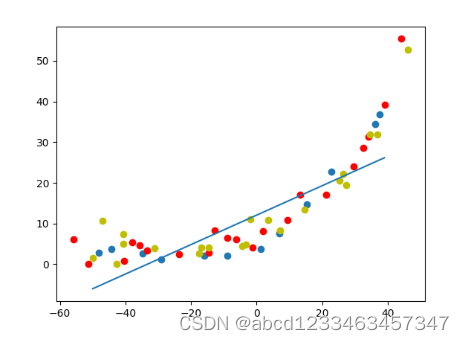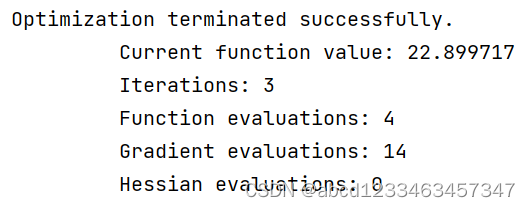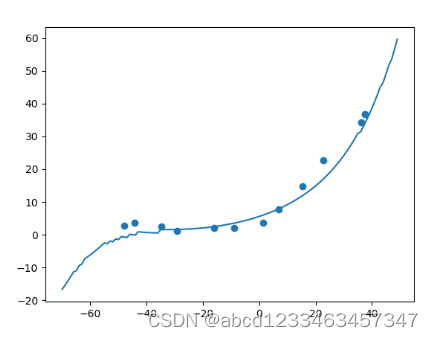参考链接:https://blog.csdn.net/weixin_44750583/article/details/88830218
第一步:使用正则化线性回归进行曲线拟合


import matplotlib.pyplot as plt
import numpy as np
from scipy import io
from scipy import optimize as opt
"""
利用最简单的正则化的线性回归函数学习bias与varience
"""
#1.读取数据
dt = io.loadmat("E:\机器学习\吴恩达\data_sets\ex5data1.mat")
#测试集
x_train = dt["X"] #(12, 1)
y_train = dt["y"] #(12, 1)
m_train = x_train.shape[0] #12
features = x_train.shape[1] #1
#训练集
x_test = dt["Xtest"] #(21, 1)
y_test = dt["ytest"] #(21, 1)
#验证集
x_val = dt["Xval"] #(21, 1)
y_val = dt["yval"] #(21, 1)
#2.数据可视化
plt.scatter(x_train,y_train)
plt.scatter(x_test,y_test,c="r")
plt.scatter(x_val,y_val,c="y")
#3.定义代价函数与梯度函数
#定义正则化的代价函数
def costFunctionRegularzation(theta,x,y,lamda = 1):
# 注意:这里得到的h是行向量(12,)
# 而这里的y是列向量(12,1)
# 如果直接h-y会得到一个(12,12)的矩阵
h = theta @ x.T # (12,)
cost0_temp = 1/(2*m_train)* np.sum(np.power((h - y.T), 2))
reg_temp = lamda / (2*m_train) * np.sum(np.power(theta[1:],2))
return cost0_temp+reg_temp
# print(costFunctionRegularzation(theta,x_train,y_train))
#定义正则化的梯度函数
def gradientRegularzation(theta,x,y,lamda = 1):
h = theta @ x.T #(12,)
#print(y.flatten().shape) #(12,)
#注意:这里不能用h-y.T,因为这样最后gradient的类型是(1,2)的二维array,与theta类型不一致
gradient = 1 / m_train * ((h - y.flatten()) @ x) + lamda / m_train * theta #(2,)
return gradient
#print(gradientRegularzation(theta, x_train, y_train)) #[[-15.21968234 598.25074417]]
def plot_fit(theta):
x = np.arange(-50, 40, step=1)
y = theta[0]+theta[1]*x
plt.plot(x, y)
plt.show
#4.调用函数
temp = np.ones((m_train,1))
x_train = np.concatenate((temp,x_train),1)
theta = np.array([1,1]) #(2, )
result0 = opt.fmin_ncg(f = costFunctionRegularzation , fprime = gradientRegularzation , x0 = theta , args = (x_train,y_train),maxiter=400)
#展示拟合曲线
plot_fit(result0)
plt.show()
第二步:画出学习曲线,对偏差-方差问题进行诊断。
从没有正则化,且只有两个特征的情况下的学习曲线可以看出,验证误差与训练误差逐渐接近且非常稳定,所以处于高偏差,欠拟合的状态。

#计算出学习曲线所需的横轴与纵轴
def learning_curve(x,y):
train_temp = np.zeros(m_train) #(12,)
val_temp = np.zeros(m_train) #(21,)
test_temp = np.zeros(m_train) #(21,)
for i in range(1,m_train+1):
theta_init = np.ones(2)
x_temp = x[0:i,:]
y_temp = y[0:i]
theta_temp = opt.fmin_ncg(f = costFunctionRegularzation,fprime=gradientRegularzation,x0 = theta_init,args=(x_temp,y_temp,0),maxiter=400) #(2,)
train_temp[i-1] = costFunctionRegularzation(theta_temp,x_temp,y_temp)
val_temp[i-1] = costFunctionRegularzation(theta_temp,x_val,y_val)
test_temp[i-1] = costFunctionRegularzation(theta_temp, x_test, y_test)
x_line = np.arange(1,m_train+1)
plt.plot(x_line,train_temp)
plt.plot(x_line,val_temp,c = "r")
plt.plot(x_line,test_temp,c = "y")
x_train = addOne(x_train)
x_val = addOne(x_val)
x_test = addOne(x_test)
learning_curve(x_train,y_train)
plt.show()
第三步:特征映射与标准化
从有正则化且特征数目有7个且标准化的学习曲线中可以看出,验证误差与训练误差之间还是存在不小的差距,所以处于高方差,过拟合的状态下。
注意点:对于验证集与测试集进行标准化时,应该使用测试集的平均值与方差


#第三步:特征映射与标准化,要注意:这里的lamda正则化项一定不能为0
#进行特征映射,将x映射成x的n次方组合的矩阵
def mapping(x,n):
temp = x
for i in range(2,n+1):
temp = np.concatenate((temp,np.power(x,i)),1)
return temp
#标准化
def normalization(x):
sigma = np.std(x, axis=0, ddof=1) # axis=0计算每一列的标准差,ddof=1表示自由度为N-1
ave = np.mean(x, axis=0)
x = (x - ave) / sigma
return x, ave, sigma
map_n = 6
xtrain,average_train,std_train = normalization(mapping(x_train,map_n))
xtrain = addOne(xtrain) #(12,7)
theta_mapping = opt.fmin_ncg(f = costFunctionRegularzation,fprime=gradientRegularzation,x0=np.ones(map_n+1),args=(xtrain,y_train,1),maxiter=400)
#绘制出拟合曲线
x_line = np.arange(-70,50,step=1).reshape(120,1)
#注意这里要对x_line标准化
x_temp = (mapping(x_line,map_n)- average_train)/std_train #这里的x要同样进行特征映射和标准化
x_temp = addOne(x_temp) #(120,7)
y_temp = x_temp @ theta_mapping #(120,)
plt.scatter(x_train,y_train)
plt.plot(x_line,y_temp)
plt.show()
#绘制出学习曲线
xval = mapping(x_val,map_n)
xval = (xval-average_train)/std_train
xval = addOne(xval)
xtest = mapping(x_test,map_n)
xtest = (xtest-average_train)/std_train
xtest = addOne(xtest)
learning_curve(xtrain,y_train,xval,y_val,xtest,y_test)
plt.show()
第四步:选择合适的正则化参数
选择10个不同的lamda值,画出训练误差与验证误差关于lamda的函数,可知lamda=1时,验证误差最小。
(我看参考链接里说应该是lamda=3时验证误差最小,因为对验证集标准化时要用训练集的平均值与标准方差,但是我对验证集标准化时使用了训练集的平均值与标准方差,还是和原来博主的结果一样)

#第四步:选择合适的正则化参数
lamdas = np.array([0,0.001,0.003,0.01,0.03,0.1,0.3,1,3,10])
val_error = np.zeros(10)
train_error = np.zeros(10)
map_n = 6
xtrain,average_train,std_train = normalization(mapping(x_train,map_n))
xtrain = addOne(xtrain) #(12,7)
xval = mapping(x_val,map_n)
xval = (xval-average_train)/std_train
xval = addOne(xval)
xtest = mapping(x_test,map_n)
xtest = (xtest-average_train)/std_train
xtest = addOne(xtest)
for i in range(10):
theta_lamda = opt.fmin_ncg(f = costFunctionRegularzation,fprime=gradientRegularzation,x0 = np.ones(map_n+1),args=(xtrain,y_train,lamdas[i]),maxiter=400)
#注意:这里计算代价函数时,应该让正则化参数为0
val_error[i] = costFunctionRegularzation(theta_lamda,xtrain,y_train,0)
train_error[i] = costFunctionRegularzation(theta_lamda,xval,y_val,0)
plt.plot(lamdas,train_error,c="r",label = "train")
plt.plot(lamdas,val_error,c="y",label = "val")
plt.show()





















 1252
1252











 被折叠的 条评论
为什么被折叠?
被折叠的 条评论
为什么被折叠?








